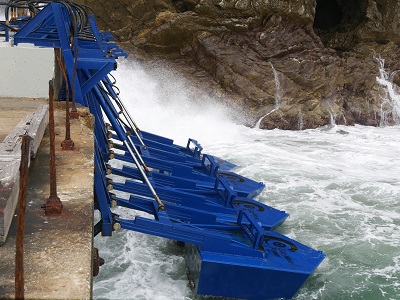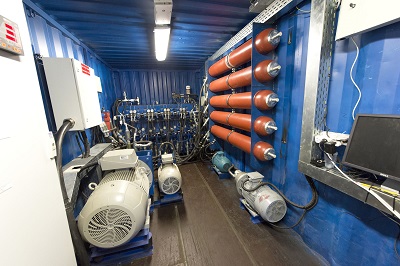Eco Wave Power is an onshore wave-energy technology company that has reportedly developed a cost-efficient system for turning the motion of ocean and sea waves into electricity. Its mission is to assist in the fight against climate change by enabling emissions-free power production. The Swedish company, based in Tel Aviv, Israel, has taken the next step towards commercialization by finalizing the assembly of the hydraulic energy conversion unit for its Jaffa Port project.

Buoyant floaters convert incoming wave action into hydraulic cylinder motion, which produces high-pressure fluid that powers a hydraulic motor and generator.
The hydraulic conversion unit is an integral part of the Eco Wave Power system as it transforms pressure (created by the waves) into clean electricity. During operation, buoyant “floaters” harvest energy by converting the rising and falling motion of incoming waves. Floater motion extends and retracts hydraulic cylinder pistons which, in essence, act as linear pumps. Cylinder action transmits high-pressure biodegradable fluid to accumulators that are mounted onshore. Pressurized fluid is stored in the accumulators and subsequently routed to a hydraulic motor. The motor turns a connected electrical generator which supplies electricity into the grid via an inverter. The fluid, after decompression, flows back to the hydraulic tank where it is then reused by the pistons, thus creating a closed-circuit system.
An automation system controls and monitors the entire operation. Generation of electricity begins at wave heights of 0.5 meters. If waves are too high, the floaters automatically lift out of the water and are stowed until the storm passes.
The entire hydraulic unit fits in a standard-sized shipping container. The compact and portable design allows for simple and efficient transportation to the working location. According to the company, the system is relatively easy to build and operate because it is installed on land, just like a traditional power station. Close proximity to grid connection points also means lower construction and maintenance expenses. Most floater installations will be to existing man-made structures like piers and breakwaters. And the system is modular and scalable.

The Eco Wave Power hydraulic conversion unit fits in a standard-sized shipping container.
The EWP design is said to be significantly more economical than offshore competition, because installation and O&M activities do not require the use of ships, divers, underwater cabling and mooring. Likewise, it is environmentally friendly as it does not mount on or connect to the ocean floor and potentially damage marine ecosystems.
Construction and production costs per KWh are said to be highly competitive. The forecast levelized cost for energy for commercial scale installation will be around $46 per MWh. That’s significantly lower than coal power generation and par with natural-gas and the best wind and solar systems.
In parallel to finalizing the assembly of the EWP hydraulic conversion unit, Siemens began electric assembly and installation work. This process will be followed by final wave simulation testing prior to transportation to the working site for installation and grid connection.
“The results achieved thus far by our engineering team and subcontractors strengthen our belief in the commercial viability of Eco Wave Power’s technology. The expansion of the Jaffa Port project, in collaboration with EDF Renewables and co-funding from the Israeli Energy Ministry, will significantly upgrade EWP technology and reduce scaling risks in our commercial-scale projects,” said Eco Wave Power CEO Inna Braverman.
Eco Wave Power
www.ecowavepower.com
Filed Under: News
